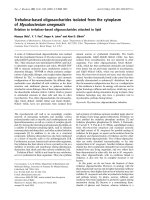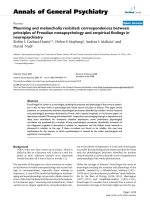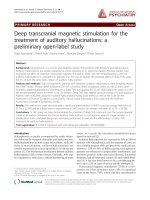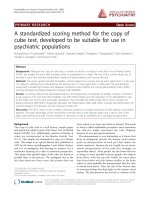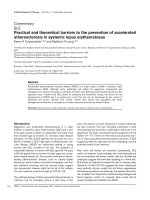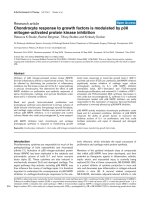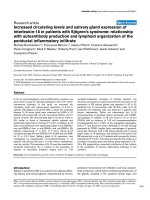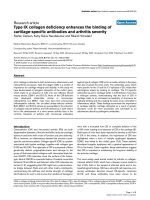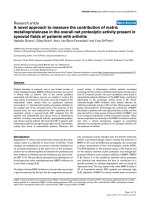Báo cáo y học: "Increased bleeding risk associated with the use of recombinant human activated protein C in patients with advanced liver diseas" potx
Bạn đang xem bản rút gọn của tài liệu. Xem và tải ngay bản đầy đủ của tài liệu tại đây (35.58 KB, 2 trang )
Page 1 of 2
(page number not for citation purposes)
Available online />Advanced liver disease (ALD) was an exclusion criteria from
enrollment in the major clinical trials of recombinant human
activated protein C (APC), but is listed on the package insert
as a relative contraindication rather than an absolute contra-
indication to APC administration [1]. There are recent reports
of elevated rates of bleeding due to APC in clinical practice,
particularly in patients with relative contraindications to the
drug [2,3]. Since many patients who develop septic shock at
Montefiore Medical Center in the Bronx, New York have ALD,
we decided to evaluate whether such patients have an
increased risk for bleeding during APC administration.
We retrospectively reviewed a database of all adult patients
who have received APC at Montefiore Medical Center since
the drug’s approval. All patients at Montefiore Medical Center
with severe sepsis at high risk for death and without absolute
contraindications are considered eligible for APC at the
discretion of the attending intensivist. Overall, 41 patients
Letter
Increased bleeding risk associated with the use of recombinant
human activated protein C in patients with advanced liver disease
Adam Keene
1
, Thomas Kawano
2
, Syed Anees
3
and Julie Chen
4
1
Division of Critical Care Medicine, Montefiore Medical Center, Bronx, New York, USA
2
Department of Internal Medicine, Montefiore Medical Center, Bronx, New York, USA
3
Division of Pulmonary Medicine, Montefiore Medical Center, Bronx, New York, USA
4
Division of Pharmacy, Montefiore Medical Center, Bronx, New York, USA
Corresponding author: Adam Keene,
Published: 11 February 2008 Critical Care 2008, 12:405 (doi:10.1186/cc6774)
This article is online at />© 2008 BioMed Central Ltd
ALD = advanced liver disease; APC = activated protein C.
Table 1
Patient characteristics and outcomes
Variable ALD present (n = 10) ALD absent (n = 24) P value
APACHE II (mean (standard deviation)) 29.3 (6.3) 27.8 (5.1) 0.46
Age (years) (mean (standard deviation)) 50.2 (6.7) 57.4 (14.8) 0.15
Male gender (n (%)) 6 (60.0) 13 (54.2) 0.75
Hispanic race (n (%)) 4 (40.0) 9 (37.5) 0.89
Black race (n (%)) 4 (40.0) 9 (37.5) 0.89
White race (n (%)) 2 (20.0) 6 (35.0) 0.75
Major surgery (n (%)) 2 (20.0) 10 (41.6) 0.23
Pulmonary source (n (%)) 7 (70.0) 9 (37.5) 0.08
Gastrointestinal source (n (%)) 1 (10.0) 8 (33.3) 0.16
Bloodstream source (n (%)) 2 (20.0) 3 (12.5) 0.57
Skin source (n (%)) 0 (0.0) 3 (12.5) 0.24
Genitourinary source (n (%)) 0 (0.0) 1 (4.2) 0.51
Major bleeding episode (n (%)) 5 (50.0) 4 (16.7) 0.04
28-day mortality 6 (60.0) 5 (20.8) 0.03
ALD, advanced liver disease as defined by the presence of chronic jaundice or ascites, cirrhosis, or portosystemic hypertension; APACHE, Acute
Physiology and Chronic Health Evaluation. P values determined by chi-squared test or Fisher’s exact test of proportions.
Page 2 of 2
(page number not for citation purposes)
Critical Care Vol 12 No 1 Keene et al.
received APC at our hospital, seven of whom were not
evaluable because of death soon after initiation of APC. Of
the 34 remaining patients, nine had major bleeding episodes.
The clinical characteristics of these 34 patients are presented
in Table 1. Five out of 10 patients (50%) with ALD had major
bleeding episodes, as opposed to four out of 24 patients
without episodes (16.7%) (P = 0.04). The bleeding events
experienced by the patients with ALD included two
gastrointestinal hemorrhages, one intracranial hemorrhage,
one major vaginal bleed, and one massive epistaxis. In a
multivariate regression model that included race, sex, and
Acute Physiology and Chronic Health Evaluation II score,
cirrhosis remained independently associated with the risk of a
bleeding event (P = 0.02, odds ratio = 23.5, 95% confidence
interval = 1.75–315). Of the five patients with ALD who had
bleeding episodes, four died within 28 days of drug
administration. Interestingly, only one out of 12 patients who
had undergone major surgery during their hospitalization
experienced a bleeding episode (this patient did not have
ALD).
Patients with ALD are at increased risk both for severe sepsis
and for bleeding. These data suggest that they may be at
greatly increased risk for bleeding while receiving APC.
Because such patients were excluded from the major clinical
trials of APC, it may be prudent to withhold therapy with APC
from all patients with ALD until data from trials that include
these patients, or further postmarketing data, are available.
Competing interests
The authors declare that they have no competing interests.
References
1. Bernard GR, VIncent JL, Laterre PF, LaRosa SP, Dhainaut JF,
Lopez-Rodriguez A, Steingrub JS, Garber GE, Helterbrand JD,
ELY EW, et al.: Efficacy and safety of recombinant human acti-
vated protein C for severe sepsis. N Engl J Med 2001, 344:
699-709.
2. Kanji S, Perreault MM, Chant C, Williamson D, Burry L: Evaluat-
ing the use of Drotrecogin alfa (activated) in adult severe
sepsis. Intensive Care Med 2007, 33:517-523.
3. Bertolini G, Rossi C, Anghileri A, Livigni S, Addis A, Poole D: Use
of drotrecogin alfa (activated) in Italian intensive care units.
Intensive Care Med 2007, 33:426-434.
